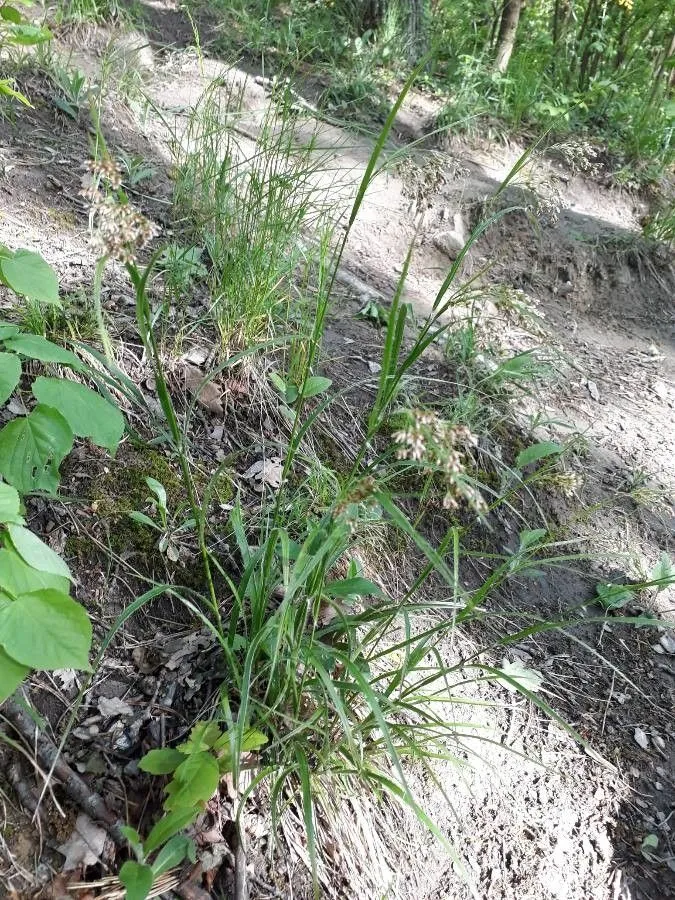
Author: (Lam.) Dandy & Wilmott
Bibliography: J. Bot. 76: 352 (1938)
Year: 1938
Status: accepted
Rank: species
Genus: Luzula
Vegetable: False
Observations: Europe
Forest wood-rush, known scientifically as Luzula luzuloides, is a captivating member of the Juncaceae family. This perennial plant is most commonly found throughout Europe, where it graces a variety of woodland habitats with its delicate presence. It was first described in detail in J. Bot. in 1938 by the esteemed botanists (Lam.) Dandy & Wilmott.
Luzula luzuloides typically thrives in shaded, forested areas, favoring the cool, moist conditions provided by its natural woodland environment. The plant is characterized by its smooth, dark green leaves that often exhibit a slight hairiness along the margins. These leaves grow in dense tufts, forming a lush, carpet-like ground cover that enhances the forest understory.
During the blooming season, the Forest wood-rush produces small, unassuming flowers that are usually white or pale in color. These flowers are arranged in loose, open clusters and contribute to the subtle, yet charming appearance of the plant. Though not particularly showy, the flowers of Luzula luzuloides play an essential role in the ecological balance of their habitat, providing a source of pollen and nectar for various insects.
One of the notable features of the Forest wood-rush is its adaptability. This plant is remarkably resilient, capable of thriving in various soil types, though it prefers well-drained, slightly acidic soils. Its ability to colonize diverse environments makes it an important species for maintaining soil stability and preventing erosion in forested regions.
The Forest wood-rush’s subtle beauty and ecological importance make it an intriguing subject for botanists and plant enthusiasts alike. Its presence in a forest signifies a healthy, well-balanced ecosystem where plant and insect life coexist in harmonious equilibrium. The plant’s historical and botanical significance, as documented by researchers such as Dandy & Wilmott, highlights its enduring place in the natural world.
In summary, Luzula luzuloides, or Forest wood-rush, is a testament to the delicate intricacies of woodland flora. It’s a resilient example of nature’s ability to thrive in shaded, moist environments, contributing both aesthetically and functionally to its surroundings. Its understated charm and environmental significance continue to be subjects of admiration and study within the botanical community.
Dan: bleg frytle
Eng: forest wood-rush, oakforest woodrush, white wood-rush, white woodrush, forest woodrush, oak forest woodrush
Lit: krūminis kiškiagrikis
Deu: weissliche hainsimse, weißliche hainsimse
Lav: birztalas zemz, birztalu zemz
Nob: hvitfrytle
Nno: kvitfrytle
Fra: luzule blanche, luzule blanchâtre, luzule des bois, luzule des bosquets
Est: salu-piiphein
Fin: valkopiippo
Swe: valkopiippo, vitfryle
Nld: witte veldbies
Sme: vilgesgiilu
Cym: coedfrwynen wen
En: Forest wood-rush, White wood-rush, Oak-forest wood rush, Forest Woodrush, Oakforest woodrush, White woodrush, Oak forest woodrush
Da: Bleg frytle
Nl: Witte veldbies
Et: Salu-piiphein
Fi: Valkopiippo
Fr: Luzule blanche, Luzule des bosquets, Luzule blanchâtre, Luzule des bois, Luzule fausse luzule
De: Weissliche Hainsimse, Weißliche Hainsimse, Schmalblättriges Hainsimse, Weiße-Hainsimse
It: Erba lucciola bianca
Lv: Birztalas zemz, Birztalu zemz
Lt: Krūminis kiškiagrikis
Se: Vilgesgiilu
Nb: Hvitfrytle
Nn: Kvitfrytle
Sv: Vitfryle, Valkopiippo
Cy: Coedfrwynen Wen
Taken Jul 11, 2010 by Tela Botanica − Yoan MARTIN (cc-by-sa)
Taken May 21, 2022 by Rico Mende (cc-by-sa)
Taken Sep 6, 2022 by Raluca Integra Vâlve (cc-by-sa)
Taken Apr 25, 2015 by Tela Botanica − Yoan MARTIN (cc-by-sa)
Taken Jun 4, 2021 by Mariusz Staniszewski (cc-by-sa)
Taken Aug 15, 2006 by Photoflora – Benoit BOCK (©)
Taken Aug 15, 2006 by Photoflora – Benoit BOCK (©)
Taken Feb 20, 2017 by Yoan MARTIN (cc-by-sa)
Taken Feb 20, 2017 by Yoan MARTIN (cc-by-sa)
Taken Oct 15, 2022 by killar (cc-by-sa)
Taken Jun 23, 2021 by Hustooo (cc-by-sa)
Taken Jan 1, 1970 by Photoflora – L’Abbé COSTE (©)
Taken May 21, 2022 by Rico Mende (cc-by-sa)
Taken Feb 20, 2017 by Yoan MARTIN (cc-by-sa)
Taken Aug 6, 2020 by wiseman simon (cc-by-sa)
© copyright of the Board of Trustees of the Royal Botanic Gardens, Kew.
Taken Apr 25, 2015 by Tela Botanica − Yoan MARTIN (cc-by-sa)
Taken May 10, 2015 by Tela Botanica − Yoan MARTIN (cc-by-sa)
Taken Jun 4, 2021 by Mariusz Staniszewski (cc-by-sa)
Taken Jun 4, 2021 by Mariusz Staniszewski (cc-by-sa)
Taken Jul 15, 2022 by beatrice le barillec (cc-by-sa)
Taken May 14, 2021 by karo turtle (cc-by-sa)
Taken May 2, 2021 by Elisabeth Ellu (cc-by-sa)
Taken Jul 11, 2010 by Tela Botanica − Yoan MARTIN (cc-by-sa)
Taken Apr 25, 2015 by Tela Botanica − Yoan MARTIN (cc-by-sa)
Taken May 10, 2015 by Tela Botanica − Yoan MARTIN (cc-by-sa)
Taken Aug 15, 2006 by Photoflora – Benoit BOCK (©)
Growth habit: Graminoid
Ph maximum: 5.0
Ph minimum: 4.5
Light: 4
Atmospheric humidity: 6
Bloom months: [‘may’, ‘jun’, ‘jul’, ‘aug’]
Soil nutriments: 3
Family: Myrtaceae Author: (F.Muell.) K.D.Hill & L.A.S.Johnson Bibliography: Telopea 6: 402 (1995) Year: 1995 Status:…
Family: Rubiaceae Author: Pierre ex A.Froehner Bibliography: Notizbl. Bot. Gart. Berlin-Dahlem 1: 237 (1897) Year:…
Family: Sapindaceae Author: Koidz. Bibliography: J. Coll. Sci. Imp. Univ. Tokyo 32(1): 38 (1911) Year:…
Family: Asteraceae Author: A.Gray Bibliography: Pacif. Railr. Rep.: 107 (1857) Year: 1857 Status: accepted Rank:…
Family: Fabaceae Author: Medik. Bibliography: Vorles. Churpfälz. Phys.-Ökon. Ges. 2: 398 (1787) Year: 1787 Status:…
Family: Aspleniaceae Author: (Cav.) Alston Bibliography: Bull. Misc. Inform. Kew 1932: 309 (1932) Year: 1932…